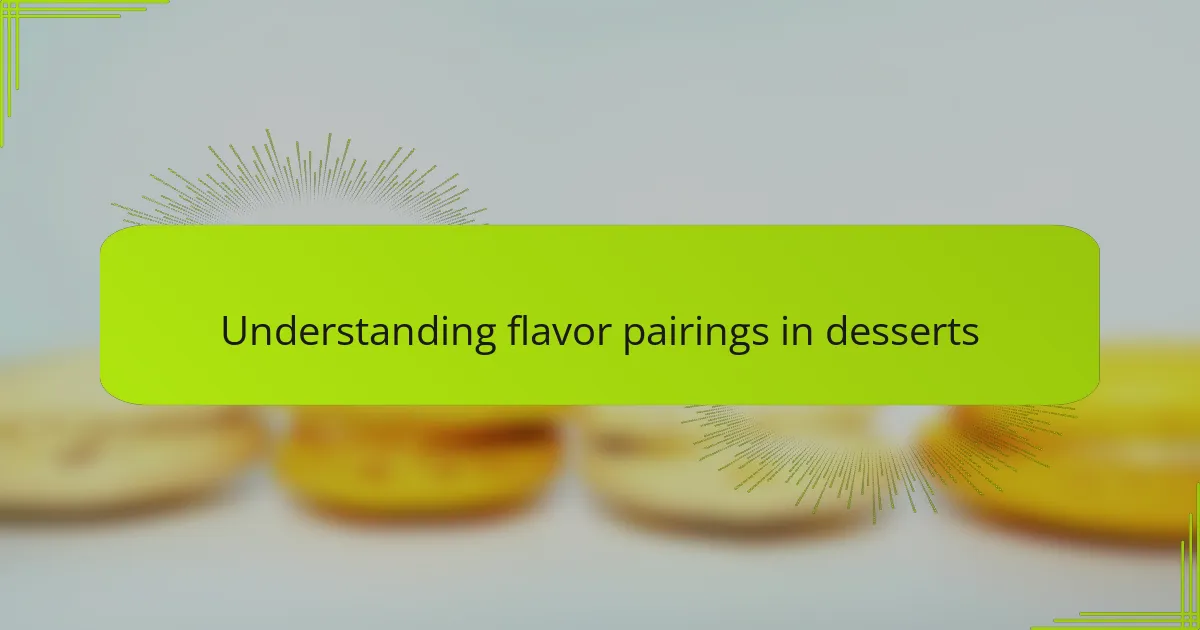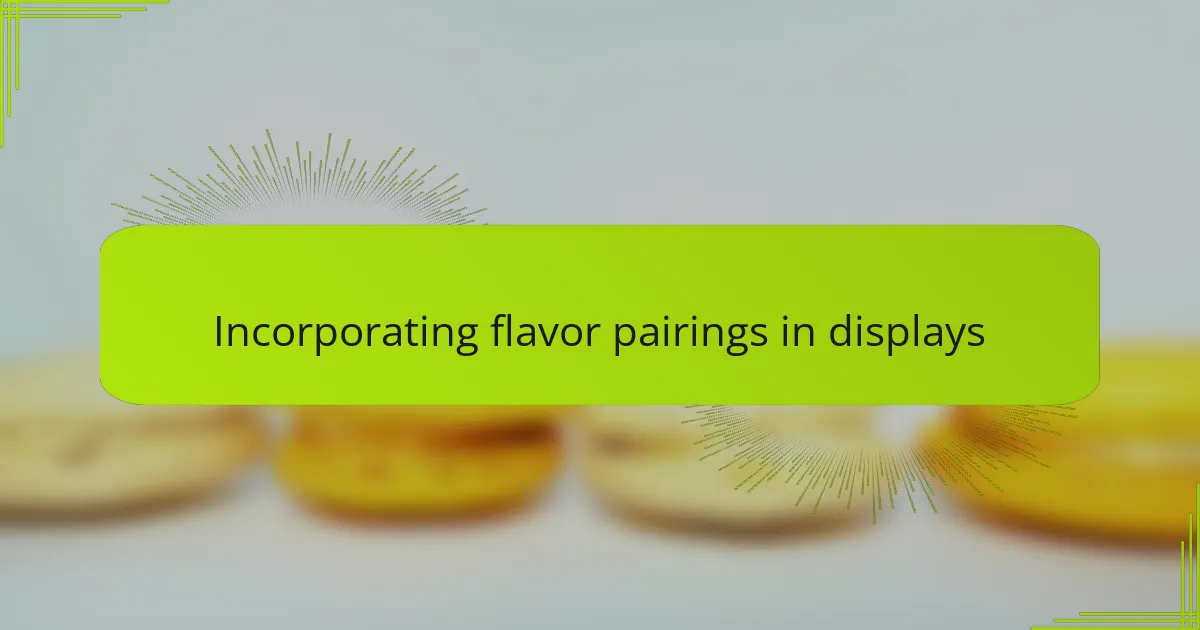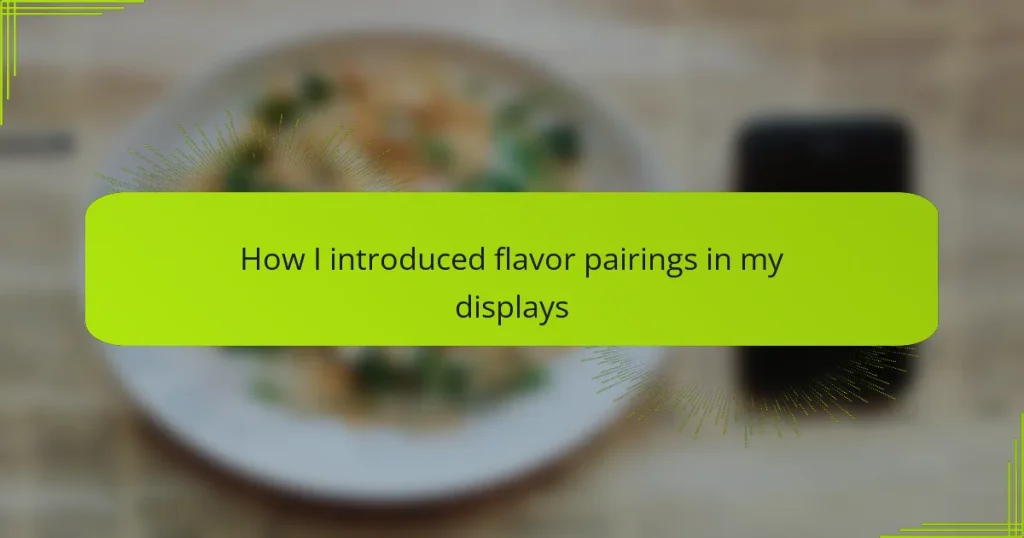Key takeaways
- Flavor pairings enhance desserts by balancing contrasting tastes, creating memorable experiences through harmony and surprise.
- Effective dessert displays rely on color, texture, height, and spacing, crafting a visual story that invites guests to engage.
- Incorporating complementary flavors is essential for a cohesive and exciting dessert experience; spatial arrangement can amplify flavor interactions.
- Personal experiences and storytelling in flavor pairings make dessert presentations more meaningful and engaging for both the creator and the guests.

Understanding flavor pairings in desserts
Flavor pairings in desserts fascinate me because they transform simple sweets into memorable experiences. I often wonder, what makes chocolate and raspberry such a classic duo? It’s this harmony of contrasting tastes—rich and tart—that sparks excitement on the palate.
Through trial and error, I discovered that understanding the underlying flavor profiles—like sweetness, acidity, and bitterness—helps me predict which ingredients will complement each other. Have you ever tasted a dessert where one flavor overpowered the others? That’s usually a sign the balance wasn’t quite right.
For me, the magic happens when flavors surprise yet comfort you simultaneously. It’s not just about mixing ingredients; it’s about creating conversations between them. When I grasp this concept, designing dessert displays feels less like guesswork and more like storytelling.

Basics of dessert display design
Designing a dessert display is like setting the stage for a flavor story. I’ve learned that balance in color, texture, and height plays a huge role in catching the eye before the first bite even happens. Have you ever noticed how an uneven or cluttered layout can make desserts feel less inviting? That’s why I make sure each element has its space to shine without overwhelming the whole scene.
I also pay close attention to the flow of the display—guiding guests naturally from one dessert to the next. It’s almost like leading someone through a menu with their eyes first. Sometimes I arrange desserts by flavor intensity or color gradients, and honestly, it makes the whole experience feel more intentional and thoughtful.
One thing I never overlook is the importance of simplicity. Early on, I tried cramming too many styles and colors together, thinking bolder meant better. But I quickly found that a clean, cohesive presentation lets the desserts speak louder. In those moments, less truly is more, and it all comes down to trusting the flavors and letting the display enhance them subtly.

Selecting complementary flavors for desserts
When I first started pairing flavors for my dessert displays, I realized quickly that not every sweet ingredient plays nicely with others. Have you ever bitten into a dessert where the flavors just clashed rather than complemented? That awkward moment taught me to focus on finding harmony—like pairing buttery vanilla with a hint of citrus to brighten things up, rather than overpowering each other.
I like to think of complementary flavors as dance partners; they need to move together smoothly. For example, combining creamy chocolate with a sprinkle of sea salt not only enhances sweetness but adds depth that surprises the palate. When I experiment with such combinations, I pay attention to how the flavors interact—do they enhance or drown each other out? That ongoing curiosity keeps my displays fresh and exciting.
Sometimes, I challenge myself by picking a bold ingredient and then searching for a subtle complement. It’s like solving a delicious puzzle. One time, I paired spicy ginger with mellow pear, and the contrast felt so balanced it almost told a story on its own. Does creating these flavor friendships make the process more immersive for you as well? For me, it’s the most rewarding part of crafting desserts.

Techniques for arranging dessert displays
Arranging dessert displays feels a bit like orchestrating a symphony where every piece needs to hit the right note visually and flavor-wise. I tend to start by grouping desserts with similar hues or shapes, which naturally draws the eye and creates a sense of harmony. Have you ever noticed how a well-placed burst of color or a cluster of treats with varying heights can instantly elevate the mood of the whole table?
One trick I rely on is layering textures within the display—crispy tarts next to silky mousses, for instance—to keep things visually and texturally interesting. It’s funny how something as simple as contrasting textures can add an invisible energy to the presentation, almost inviting you to taste each item more eagerly. When I arrange desserts this way, I feel like I’m giving guests a little journey through different sensations.
I also pay careful attention to spacing, resisting the urge to crowd too many items together. In my experience, a bit of breathing room turns an ordinary display into a stunning focal point where each dessert can shine. Isn’t it amazing how simplicity can sometimes speak louder than extravagance? That balance between abundance and clarity is something I’m still learning to master, but it’s worth every moment spent arranging.

Incorporating flavor pairings in displays
Incorporating flavor pairings into dessert displays changes the way I think about arranging sweets. Instead of simply placing desserts side by side, I consider how their flavors will interact when experienced sequentially. Have you ever noticed how moving from a rich chocolate tart to a zesty lemon cookie can refresh your palate? That contrast isn’t accidental—it’s a deliberate choice to keep each bite exciting.
I like to create clusters of desserts that share complementary flavors, using their arrangement to tell a subtle story. For example, grouping berry-infused treats near vanilla-based ones not only highlights their flavor connection but also makes the visual display feel cohesive. It’s fascinating how spatial placement on a platter can amplify the flavor dialogue before anyone even takes a bite.
Balancing bold and delicate flavors in the display is another technique I’ve grown fond of. By positioning a spiced dessert next to something lighter, like a creamy mousse, I guide guests through a flavor journey that feels natural and satisfying. Sometimes I wonder if the way flavors are arranged visually influences how much we expect to enjoy them—and from my experience, it definitely does.

Personal experiences with flavor pairings
I remember the first time I paired unexpected flavors in a display—think dark chocolate with a hint of lavender—and it was like unlocking a secret conversation between ingredients. The surprise on my guests’ faces told me that flavor pairings aren’t just about matching tastes but about evoking emotions. Have you ever experienced that moment when a bite transports you somewhere new? That’s the power I chase in every pairing.
There were plenty of moments when my experiments fell flat, like mixing mint with too much sweetness and ending up with a muddled mess. Those failures taught me just as much as the successes; I learned to trust my instincts but also to listen carefully to what each flavor needs to truly shine. Doesn’t it feel rewarding when you finally get that perfect balance after several tries?
Sometimes, I get inspired by memories—like pairing caramel with sea salt because it reminds me of coastal evenings. Creating those personal flavor stories makes my displays more meaningful to me and, I hope, to those who taste them. Do your favorite combinations carry stories too? For me, that narrative thread makes pairing flavors a deeply satisfying creative journey.

Tips for mastering dessert presentations
Mastering dessert presentations starts with seeing each element as part of a bigger visual story. I’ve found that playing with height and color contrast doesn’t just catch the eye—it sets a mood that invites people to dive in. Have you noticed how placing a vibrant dessert next to something more neutral can instantly make both pop? That little trick turns a simple table into an irresistible display.
Another tip I treasure is paying attention to the details that guests might not voice but definitely feel—like spacing. Early on, I crammed too many sweets together, thinking more meant better. But giving each dessert enough breathing room transformed my displays into welcoming, elegant showcases that felt more intentional. Isn’t it amazing how a bit of empty space can highlight the beauty of every single piece?
I also rely on layering textures within the presentation to create subtle excitement. Combining crunchy, creamy, and airy desserts in one display is like crafting a tactile story that pleases the eye and teases the palate. When I see guests eager to try every bite because the display promises diverse sensations, it reminds me why mastering presentation is as much about anticipation as taste.




